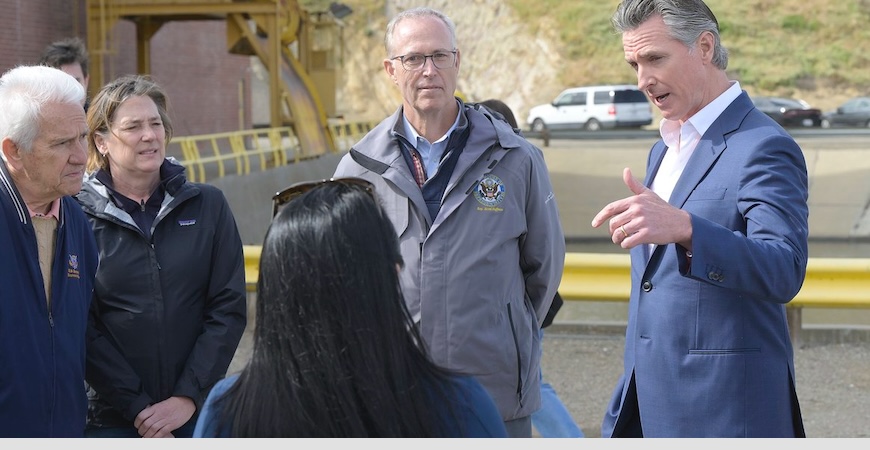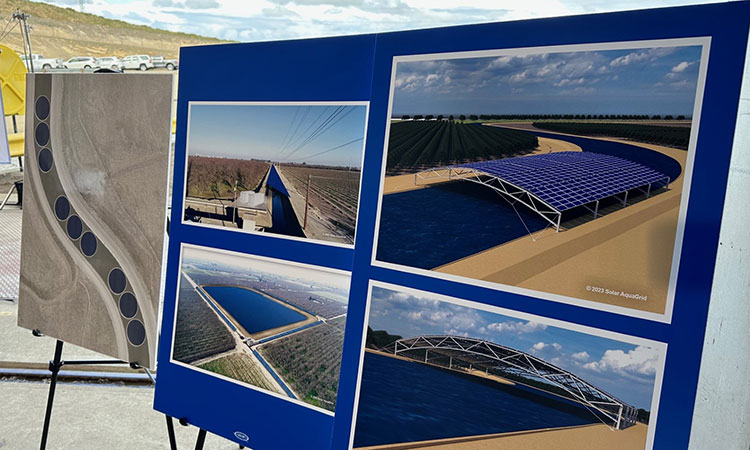
Federal and state government officials journeyed to the western corner of Merced County on Thursday to announce a new project to place solar panels on the water in the Delta-Mendota Canal.
The project is part of a $19 million investment through President Joe Biden’s Inflation Reduction Act announced by the Department of the Interior to install panels over irrigation canals in California, Oregon and Utah, with the aims of decreasing evaporation of critical water supplies and advancing clean energy goals.
The Delta-Mendota Canal floating solar project is set to receive $15 million of this funding. The Bureau of Reclamation said the agency will collaborate with the San Luis and Delta-Mendota Water Authority and the University of California through a public-private-academic partnership to assess the impacts of floating photovoltaic solar arrays on the canal.
The pilot program intends to deploy up to three different technologies to assess the viability, costs and benefits of floating solar arrays over large conveyance facilities like the Delta-Mendota Canal. The initiative also will identify and address issues related to maintaining a canal with panels on it, explore the power generation potential and develop methods to quantify impacts on water quality.
Gov. Gavin Newsom, who attended the announcement at the O’Neill Forebay near Santa Nella, said the Delta-Mendota effort will complement work the state has been doing with UC Merced, the Turlock Irrigation District and Solar AquaGrid. Project Nexus, as that venture is called, will install solar panels over two spans of TID canals.
“In 2022 we set aside a $20 million appropriation and started to do these designs,” Newsom said.

The previous year, UC Merced and UC Santa Cruz published a study showing that covering California’s approximately 4,000 miles of public water delivery infrastructure with solar panels could result in significant water, energy and cost savings for the state. The study projected a savings of up to 63 billion gallons of water annually – enough to irrigate 50,000 acres of farmland or meet the residential water needs of more than 2 million people.
“You couldn’t read that without thinking, ‘Why didn’t we do this 25, 30 years ago?’” Newsom said. “This is a no-brainer. This is common sense.”
Installing solar panels on irrigation canals could provide benefits that include generating renewable energy, reducing evaporation losses, increasing efficiency of and production from solar panels because of the cooling effect of the water beneath the panels, creating land savings for open space and agricultural use, reducing facility maintenance by mitigating algae and/or aquatic plant growth, and reducing the energy footprint and carbon emissions required to operate and maintain the facility.
“It’s exciting to see research become reality through projects such as these, which have so much potential,” said UC Merced project scientist Brandi McKuin, who conducted the initial study.
Other efforts funded through the Inflation Reduction Act are a project to float photovoltaic solar panels on a canal in Oregon and covering canals with solar panel structures in Utah. A previous award of $5.65 million will fund the construction and installation of solar panels over a canal in the Gila River Indian Community in Arizona.
“I think we’re going to look back at this moment and wonder what the hell took us so long,” Newsom said, “but also be very, very proud of this moment and the progress we’re announcing and advancing here.”




 Public Information Officer
Public Information Officer

